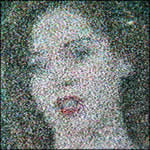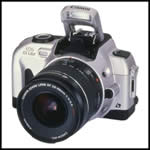Gary's Parries 30/04/06
 This week’s Gary’s Parries topics are:
This week’s Gary’s Parries topics are:
1. Hesitant To Buy Noisy Panasonic LX1
2. Have Lens, Will Travel
3. Ramblin’ Man
Introducing this week’s Gary’s Parries column. Everything you always wanted to know about digital cameras, but were afraid to ask. No question too difficult, or too easy. As a Senior Principal Software Engineer, and a former Assistant Professor of Computer Information Systems, as well as a recording studio owner/operator, and now, a digital camera enthusiast, GARY has more digital camera knowledge in his entire brain than most people have in their little finger. In the unlikely event that GARY would not know the answer to your question, he will answer it anyway, true to the spirit of the word “Parries”, a fencing term which, in this context, implies “cleverly evasive answers”. So let your imagination run wild. Email all your nagging digital camera questions to: [email protected], and then, En Garde!
You may also attach to your email an ORIGINAL PHOTO of your choosing. A preview of the photo will be displayed with your question, and a full-sized version will be just a click away (unless you request otherwise). No personal information will be published with your question unless you specifically include it in the text or attached photo of your email, which may be further edited for grammar, content, or other reasons.
***
*** QUESTION 1—- HESITANT TO BUY NOISY PANASONIC LX1
***
 If a camera, such as the Panasonic Lumix DMC-LX1, has a high degree of noise, can the company issue a firmware upgrade that will reduce the problem (i.e., one that reprograms the chip itself)?
If a camera, such as the Panasonic Lumix DMC-LX1, has a high degree of noise, can the company issue a firmware upgrade that will reduce the problem (i.e., one that reprograms the chip itself)?
If you use RAW mode, what degree of improvement can you achieve?
I really like the LX1, for its manual controls, and most of all for its 16:9 aspect ratio, but I am hesitant to buy it because of image noise?
Thanks,
Dwight Costabile
***
*** ANSWER 1
***
Dwight, first we need to clarify our use of the term “chip.” When a company issues a firmware update, they are reprogramming the internal microprocessor chip which controls the camera’s functionality. This is different from its image sensor chip, which is strictly hardware controlled, and not firmware reprogrammable (at least not yet, but with recent technological advances in CMOS image sensors, you never know).
Even though a camera’s image sensor is not reprogrammable, manufacturers can and do issue firmware upgrades to improve image noise by providing a more effective noise reduction algorithm that may have been developed subsequent to the camera’s release. The upgrade does not change the output of the image sensor, per se; rather, it processes the sensor’s output data in an attempt to remove its image noise.
What these noise reduction algorithms do is look at each pixel in the perspective of its surrounding pixels to determine if that pixel “fits in” with the others. If it does not fit in, it is likely that the pixel has been corrupted by noise, in which case an attempt is made to artificially alter the pixel so that it fits in better, thus reducing the effect of the noise.
The main problem with such noise reduction algorithms is that it is often difficult to distinguish whether a pixel does not fit it because of noise, or because of an actual abrupt change in the image’s detail. If a noise reduction algorithm becomes too aggressive at eliminating noise, it will also eliminate much of the desired fine detail of an image.
There is definitely some advantage to using a camera’s RAW mode when it comes to noise reduction; however, it has nothing to do with the camera’s “internal” noise reduction algorithms, since those are generally applied to an image sensor’s raw data (i.e., prior to any JPEG processing). Where the advantage of RAW mode comes in is with computer post-processing.
Computer microprocessors have orders of magnitude greater processing power than camera microprocessors; therefore, computer noise reduction software can be much more effective than a camera’s internal algorithms when it comes to being able to distinguish image noise from the fine details of an image. Couple that with the fact that computer software can do a much better job with RAW data than it can with JPEG compressed and processed data, and you can see how using a camera’s RAW mode would allow for more effective noise reduction in post-processing.
I would not count on Panasonic announcing a firmware upgrade for the LX1 to reduce image noise. If you buy an LX1, you can either manually set the ISO to no higher than 100, thus avoiding image noise, or you can expect to do a lot of post-processing of your images on the computer. If you go the post-processing route, the camera’s RAW mode will enable more effective noise reduction; however, it will also slow the camera down to a crawl due to its having to handle much larger image files.
Panasonic’s latest crop of cameras all seem to have better noise performance than the LX1, and they also offer a 16:9 aspect ratio, although it is achieved with cropping, and thus with reduced resolution, unlike the LX1, where the CCD’s aspect ratio is a true 16:9.
***
*** QUESTION 2—- HAVE LENS, WILL TRAVEL
***
 I own an old Canon APS SLR called the IX Lite. It took great APS photos at the time, but it’s time to go digital.
I own an old Canon APS SLR called the IX Lite. It took great APS photos at the time, but it’s time to go digital.
Will the Canon EF 22-55mm lens that came with this camera work well with a Canon EOS Digital Rebel? Will there be any conversion factors?
Thanks for your help.
***
*** ANSWER 2
***
Good news! Your Canon EF 22-55mm lens will match up perfectly with a Canon EOS Digital Rebel, and with almost the identical field of view as your APS SLR, just slightly longer focal lengths due to the fact that the Rebel’s APS-C image sensor is slightly smaller than the frame size of APS film.
The lens conversion factor for a Digital Rebel is 1.6x, so your lens will now equate to a 35mm film camera lens of 35-88mm, whereas the lens conversion factor for your IX Lite was 1.5x, so your lens equated to a 35mm film camera lens of 33-83mm.
Keep in mind that the Digital Rebel’s kit lens is an EF S 18-55m, which is a wider lens than yours, and also a stop faster than yours. But unlike your EF lens, the EF S lenses cannot cover a 35mm, full-frame sensor. If you should decide to go that route at some later time, the EF S lens will produce vignetting, whereas your EF lens will still work just fine.
P.S. Glad to hear you’re going digital !!!
***
*** QUESTION 3—- RAMBLIN’ MAN
***
 From this morning’s ramblings ... this Samurai house always fascinates me. These photos are untouched except for a slight tilt adjustment. Final picture will naturally be sharpened and darkened a bit. As a rule I usually shoot on the light side, always tweaking in PS anyway. Just a quirk left over from my film days, to get more shadow detail. Photos reflect the wide view of the Kodak EasyShare V570’s 23 mm prime lens vs. the wide end of its 39-117mm zoom lens.
From this morning’s ramblings ... this Samurai house always fascinates me. These photos are untouched except for a slight tilt adjustment. Final picture will naturally be sharpened and darkened a bit. As a rule I usually shoot on the light side, always tweaking in PS anyway. Just a quirk left over from my film days, to get more shadow detail. Photos reflect the wide view of the Kodak EasyShare V570’s 23 mm prime lens vs. the wide end of its 39-117mm zoom lens.
What do you think, Gary?
Semper Fi,
Nick in Japan
P.S. Tried my V570’s stitching program this morning. Hand-held, kinda neat, but no software in the Nittsu printer yet. Nagawa-san says maybe next week.
***
*** ANSWER 3
***
Nick, in comparing the field of view of the top image at 23mm with the bottom image at 39mm, I see what you mean about the wide view of the V570’s 23mm prime lens. I did, however, expect to see more of a perspective distortion with the 23mm lens, but I guess that is what you meant when you said you applied a slight tilt adjustment in Photoshop.
How slight? What about the in-camera perspective adjustment, is that any good?
I also see what you mean about shooting a little on the light side. As you suggested, without it, the shadows (such as in the entranceway of the house) would show no detail, whereas, at your slightly higher exposure, you were able to capture some of the detail. (BTW, the Kodak EasyShare V610 has in-camera shadow lightening which automatically brings up the shadow detail while shooting at normal exposure).
How long do you think it will be before Kodak has a camera with a 38-380mm zoom like the V610, PLUS a 23mm prime like the V570? Maybe they could do it with THREE lenses?
P.S. Really neat panorama. Hard to believe it’s hand-held. I just hope Mark can do it justice here. FYI, my wife’s printer, the HP Photosmart 475, does 4” x 12” panoramas, so I will have to get some panorama paper for it and give your photo a try.
***
[Column photo “The Photographer” by Brenda LaFleur of Brenda LaFleur Photography.]

